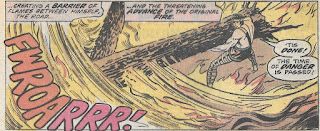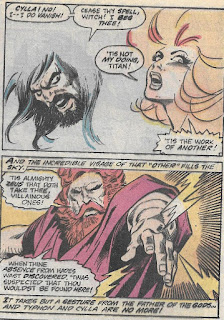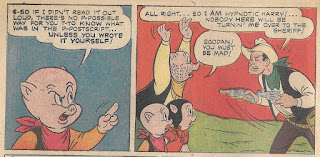Laramie, which ran on NBC from 1959 to 1963, was not in syndication when I was growing up. At least not where I was growing up. So, though I was well-steeped in
Gunsmoke,
Bonanza, The Rifleman and
Big Valley, I didn't happen to see an episode of
Laramie until I was well into my adult years.
That meant that Robert Fuller was, in my mind, the doctor from
Emergency. So what the heck is Dr. Bracket doing wearing a six gun? And who's manning the E.R. while he's shooting it out with outlaws? Where's Gage and DeSoto? It actually took an effort to wrap my mind around the idea that he had been a cowboy--I hadn't seen later seasons of
Wagon Train at that point either.
Despite the absence of paramedics,
Laramie was a good, solid show. Many consider it one of the best Westerns of its time. I haven't seen enough episodes to pass judgement, but I have liked the ones I've seen.
The premise is a neat one--Slim Sherman, along with his young brother Andy and his partner Jess Harper run a stage stop near Laramie. Jonesy--played by Hoagie Carmichael--also worked there during the first season. It's a premise that allows for different characters to pass through their lives, bringing various adventures to their doorstep.
Dell Comics devoted three issues of the anthology book
Four Color to
Laramie and also gave the show a single issue of its own. All four of these comics tell good solid Westerns backed with excellent artwork. In fact,
Four Color #1125 (Aug-Oct. 1960) is especially notable in its art.
The pencils are by Gil Kane and the inking was done by Russ Heath. Kane and Heath were two of the best artists in the industry during the Silver and Bronze ages.
FC #1125 has two very well-written stories (the writer is unknown), but its the art work that really shines. The book is a pleasure to simply look at.
The first story is "The Stage Frame-Up." A stage with no driver charges past the station. Slim catches and stops it, but there's no sign of the driver or the money that was aboard.
Later, the driver's body and the empty strongbox that had carried the money are found at Slim's station. Someone is framing him for murder & robbery.
I love the attention to detail in the art that helps to subtly set the mood. The top right panel above, for instance, has the top of Slim's head in shadow, highlighting the shocked expression centered in his eyes when the body is found. I wonder if that was something Kane indicated when he did his pencil work, or something Heath added with the inks. It's the sort of emotional touchstone that both men were brilliant at creating.
The killing is actually a plot by a local rancher to get the contract for the stage stop. Slim and Jess do some investigating, find out what's going on and set a trap. After a sharp and violent shoot-out, they catch the real villains and get the proof they need.
The story really is well-written, with the story progressing in a very logical manner.
"The Passenger" involves a witness to a murder being escorted to the trial by a lawman. But the witness doesn't trust the law to protect him. When the stage stops at Laramie, he knocks out Jonesy and makes a break for it.
This is a bad idea--soon the gang he would be testifying against is after him, while Slim and his crew find themselves pinned down inside the station. Slim and Jess use a home-made smokescreen to slip away, which leads to a confrontation between themselves, the witness and the gang inside a huge cavern.
The ensuing gunfight is nothing less than remarkable--comic book art at its best. The action is clearly laid out, so that we always know what's going on; the tension is high as Jess struggles against several outlaws for possession of a gun; and light & shadows are expertly used to highlight the action and generate the appropriate atmosphere.
Four Color #1125 is now in the public domain, so you can read it online
HERE.
Next week, we'll move from the Wild West to the equally Wild East, trading in our six guns for some giant robots.


 Meanwhile, Maur-Kon's lieutenant Magar is still up to shenanigans. Maur-Kon and Magar have a
Meanwhile, Maur-Kon's lieutenant Magar is still up to shenanigans. Maur-Kon and Magar have a  While all this is happening, Maur-Kon is using Combatra to clean the collective clocks of the other Shogun Warriors. Fortunately, Genji shows up in a "borrowed" tank and knocks Combatra's block off with a surprise shot.
While all this is happening, Maur-Kon is using Combatra to clean the collective clocks of the other Shogun Warriors. Fortunately, Genji shows up in a "borrowed" tank and knocks Combatra's block off with a surprise shot. The Real Glory does a magnificent job of gradually building up suspense as the story progresses, combining the worsening situation with just an occasional action scene to increase the tension to a fever pitch by the time we arrive at the climax.
The Real Glory does a magnificent job of gradually building up suspense as the story progresses, combining the worsening situation with just an occasional action scene to increase the tension to a fever pitch by the time we arrive at the climax.
 Hercules had met the other Champions on a college campus where he was appearing as a lecturer. I love that, by the way. It makes so much sense in a universe where the Greek myths are a part of real history to ask an immoral demi-god to give talks on the subject.
Hercules had met the other Champions on a college campus where he was appearing as a lecturer. I love that, by the way. It makes so much sense in a universe where the Greek myths are a part of real history to ask an immoral demi-god to give talks on the subject. Hercules comes out on top, of course. There's a wonderful bit in which Fenster then wonders if they can get Typhon to join them on the lecture circuit, but Zeus ruins this idea by zapping the Titan and the witch both back to Hades.
Hercules comes out on top, of course. There's a wonderful bit in which Fenster then wonders if they can get Typhon to join them on the lecture circuit, but Zeus ruins this idea by zapping the Titan and the witch both back to Hades. 


